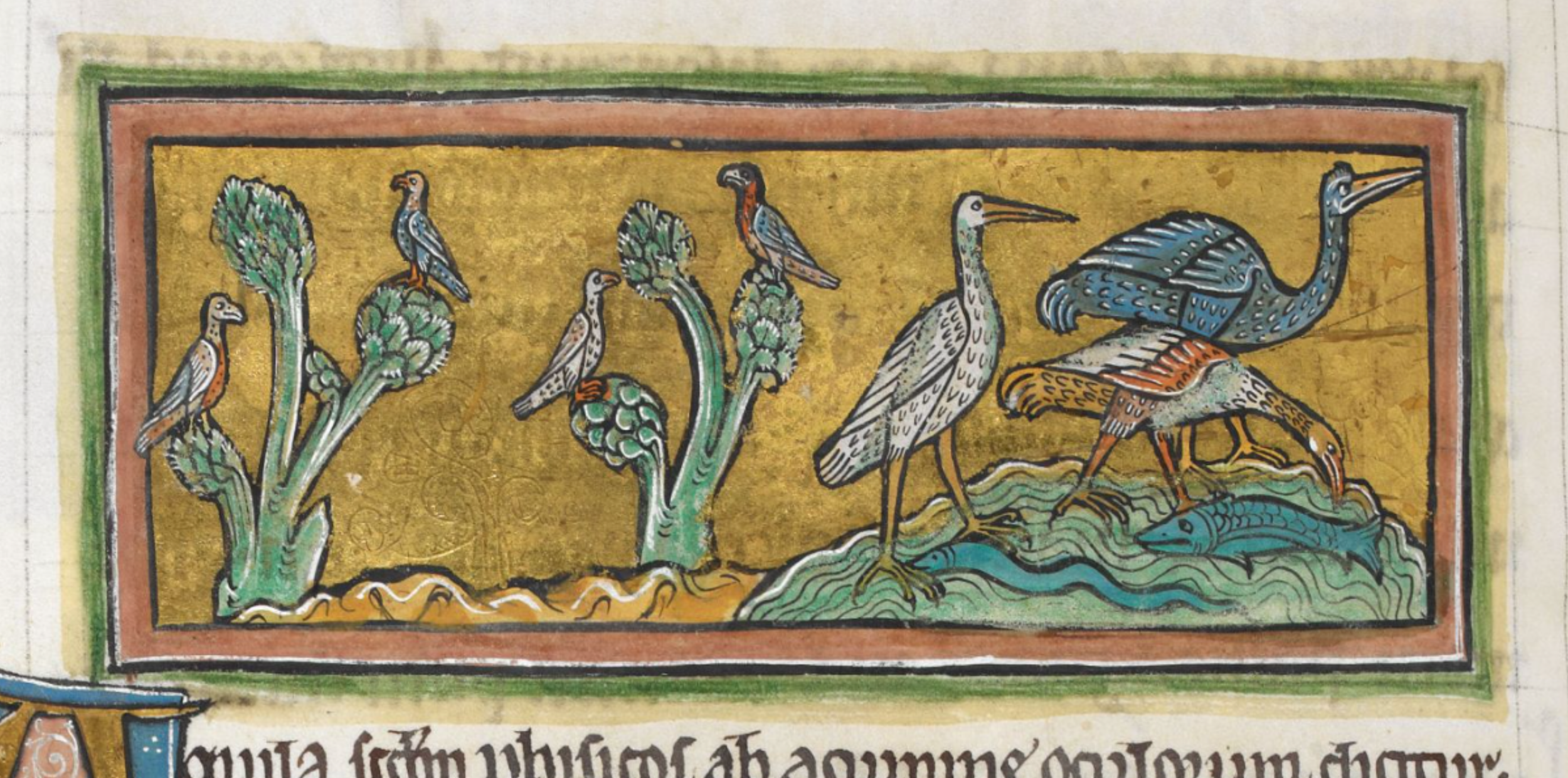
On the naming of birds, Rochester Bestiary, c.1230
Search page
Search within this page here, search the collection page or search the website.
Index
Eagle, Rochester Bestiary, c.1230
Vulture, Rochester Bestiary, c.1230
On the naming of birds, Rochester Bestiary, c.1230
In the world of birds, there is a singular name, ăves, wherein there lies a remarkable diversity of species. These avian creatures vary not only in species but also in their nature and behaviours. Some are as unassuming as doves, whereas others exhibit cunning akin to partridges. Certain birds, like hawks, readily perch on a human's hand, whereas others, like the elusive garramantes, shun such contact. Swallows find joy in human company, whereas turtledoves prefer solitary lives in the desert. Geese contentedly feed on grains they find on the ground, whereas kites are adept hunters hurling themselves at their prey.
In the world of birds, there is a singular name, ăves, wherein there lies a remarkable diversity of species. These avian creatures vary not only in species but also in their nature and behaviours. Some are as unassuming as doves, whereas others exhibit cunning akin to partridges. Certain birds, like hawks, readily perch on a human's hand, whereas others, like the elusive garramantes, shun such contact. Swallows find joy in human company, whereas turtledoves prefer solitary lives in the desert. Geese contentedly feed on grains they find on the ground, whereas kites are adept hunters hurling themselves at their prey.
With countless species, each exhibiting unique behaviours and characteristics, it is impossible to quantify the sheer diversity of birds. Even explorers venturing into distant deserts like Scythia, India, and Ethiopia could not claim familiarity with all avian species or their distinctions.
The very essence of birds is captured in their name—ăves—a term reflecting their propensity for wandering hither and thither, never bound to straight paths. They are called ālĭtes, winged creatures, for their upward flight and the motion of their wings. The act of walking, ambŭlare, stems from vŏlo to fly, highlighting the connection between avian flight and terrestrial locomotion.

Feathers play a pivotal role in the avian world, enabling flight and nurturing young chicks with tender care. The names of birds often echo the sounds of their calls, from the majestic crane to the mysterious owl, demonstrating the deep connection between their vocalizations and their identities.
In summary, the world of birds is a fascinating tapestry of diversity, behaviours, and interconnectedness, where each species contributes to the intricate symphony of nature.
F46v
Nam sicut specie sibi differunt; ita et nature di-
versitate. Nam alie simplices sunt sicut columbe.
Alie astute; ut perdix. erasure Alie ad manum se subiciunt.
ut accipitres. Alie reformidant; ut garramantes. Alie
converstionem hominum delectantur ut hyrundo. Alie
in deserto secretam vitam diligunt; ut turtur. Alie
solo semine reperto; pascuntur. ut anser. Alie carnes
edunt et rapinis intendunt; ut milvus. Alie grega-
tim volante; ut sturni et coturnices. Alie solivage;
id est solitarie propter insidias depredandi ut aquila et
accipiter. Alie voce strepunt ut hyrundo. Alie cantus
edunt dulcissimos ut cignus et merula. Alie verba
et voces hominum imitantur. ut psitacus. et pica. Sed
alia sicut genere; ita et moribus innumerabiles. Nam
et volucrum quot genera sunt; invenire quis non
potest. Neque omnia scithie et indie ac ethiopie deser-
ta quis penetrare potuit. qui earum genus vel diffe-
rentias nosset. Aves dicte; eoquod rectas vias non habent.
F47r
ad alta tendunt. et ad sullimia remigio alarum con-
tendunt. Volucres a volando. Nam unde volare; inde
et ambulare dicimus. Vola enim; est. media pars pedis
vel manus. et in avibus; media pars alarum. quarum
motu; penne agitantur. inde volucres pulli dicuntur.
Et homo parvus; pullus. Recentes nati igitur pulli dicunt-
tur. eoquod polluti sunt. Unde et vestis nigra; pulla
est. dicta. Alie sunt in quibus penne per ordinem fixe vo-
landi exhibent usum. Vocate autem ale; quod hiis
aves complexus alant. ac fovent pullos. penna; a
pendendo id est a volando; dicta. Unde et pendere. Volucres
enim pennarum auxilio moventur; quando se aeri;
mandant. Pluma; quasi piluma. Nam sicut pili in
quadrupedum corpore; ita pluma in avibus. Avium;
multa nomina a sono vocis constat esse. composita.
Ut grus. corvus. cignus. bubo. milvus. ulula. cu-
culus. garrulus. graculus et cetera. Varietas enim vo-
cis earum; docuit quid homines eas vocarent.
Further Reading
Mynott, J, Birds in the Ancient World (New York: Oxford University Press 2018)Josh Goldenberg (BA 2012) and Matt Shanahan (BA 2014), Logeion, November 2022, https://logeion.uchicago.edu/
Castiglioni, L. and Mariotti, S. (1996). Vocabolario della Lingua Latina: Latino-Italiano Italiano-Latino. Terza Edizione. Loescher Torino
Curley, M. J., Physiologus: A Medieval Book of Nature Lore (University of Chicago edition 2009)
Rackham, H., M.A., Pliny Natural History Volume III, Libri VIII-XI (London: William Heinemann Ltd, 1949)
Collins, A. H., M.A., Symbolism of Animals and Birds (New York: McBride, Nast & Company, 1913)
Henderson, C., The Book of Barely Imagined Beings (London: University of Chicago Press, 2013)
White, T. H., The Bestiary: A Book of Beasts (New York: G.P Putnam’s Sons, 1960)
Matthews, J. and Matthews C., The Element Encyclopedia of Magical Creatures: The Ultimate A-Z of fantastic beings from myth and magic (London: HarperElement, 2005)
Barney, S. A., Lewis, W. J., Beach A., Berghof O., The Etymologies of Isidore of Seville (New York: Cambridge University Press, 2006)
Footnotes
[1] Plural form of ăvis, bird.
[2] The Garamantes were an ancient population that may have descended from the Berbers and lived in the Fezzan region in 1000 BC. Apparently, the Garamantes gave their own name to a local species of birds. According to Isidore’s Etymologies (12.7.1), written about 200 years later, these birds were afraid of approaching people. https://en.wikipedia.org/wiki/Garamantes
